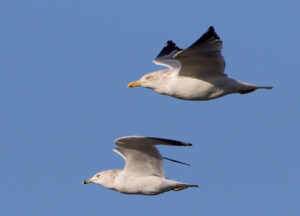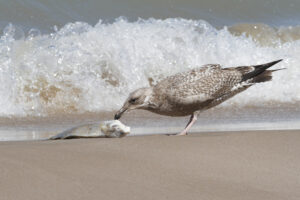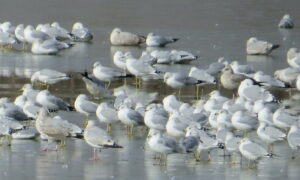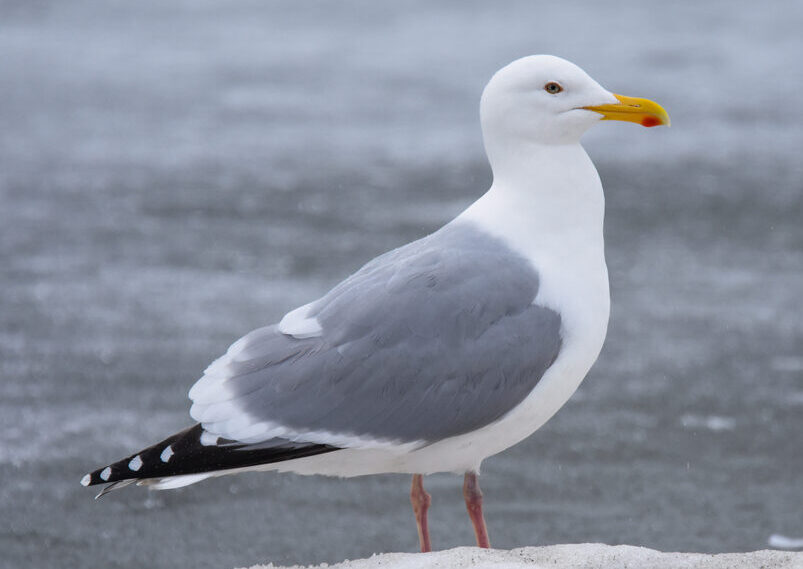Herring Gull, Larus argentatus
Bill Rowe
Cool weather brings us Herring Gulls from the north, and winter weather, especially a snow-and-ice situation, brings more of them. This big gull nests all across Canada and down into the northern states, like our commonest species, the Ring-billed Gull; very occasionally, in an extreme cold snap, it may effectively replace the Ring-bill for a while on our rivers and lakes, but that is most unusual. As with other gulls, the plumage of Herrings is the same for males and females but changes with age; this species is our prototype of a “four-year gull” (see Identification). Like the Ring-bill, the Herring subsists primarily on fish and will often be seen swirling around the spillway below a dam, or resting on perches like lock walls, sandbars, and ice. Herring-type gulls live all around the northern hemisphere, providing ornithologists with plenty to debate on the subject of how many species there are. The European and American Herring Gulls do differ in some ways, and Old-World authorities now consider them two separate species, while the Americans have not yet taken that step (they count them as subspecies). Then there are the Yellow-legged Gulls of the Mediterranean, the Vega Gulls of Siberia, and others…but in any case, they all play similar roles ecologically and count as the standard “large gray-mantled gull” wherever they may be.
IDENTIFICATION: An adult Herring Gull is a fairly large bird, about two feet long. In breeding plumage (see above) it has a light gray back and wings (the “mantle”) with black wingtips and a white head, tail, and underparts, becoming streaked on the head in winter. Its bill is stout, yellow with a red spot near the tip, and its legs are pink; both of these features distinguish it from an adult Ring-bill, in addition to its larger size. To reach this stage, however, a Herring Gull’s plumage changes dramatically, from all brown in its first year, to some gray emerging on the mantle in year 2, to mostly gray like an adult but with some tell-tale imperfections in year 3, to fully adult by year 4. Thus the field marks you use to distinguish a Herring Gull from various others depend partly on knowing its age. Telling it from a Ring-bill is usually easy, but being able to separate such species as Lesser Black-backed and Iceland Gulls, especially at their younger ages, can be complicated and requires special study. Bottom line: first learn the Herring Gull well.
ST. LOUIS STATUS: Most numerous along the Mississippi River at places like Winfield and Riverlands, and at Carlyle Lake; typically begins to arrive in September-October and becomes common in late fall and winter, through March and early April. Occasionally seen in warmer months.
Learn more and listen to the calls of Herring Gulls here.



Winter adult Herring and
Ring-bill in flight
Photo Credit: Al Smith
Year 1: Mottled brown
Year 2: Gray coming in on back
Photo Credit: Al Smith

How many Herring Gulls can you find among the Ring-bills?
Try to find year 1, year 2, year 3, and adult. See answer below.
Photo Credit: Bill Rowe
Answer: At least 9 Herring Gulls: one in year 1 (brown bird at right), three in year 2 (one in front row, far left), one in year 3 (front row, to the right of the year 2 bird), three adults (one in front of the year 1 bird), and at least one uncertain.




